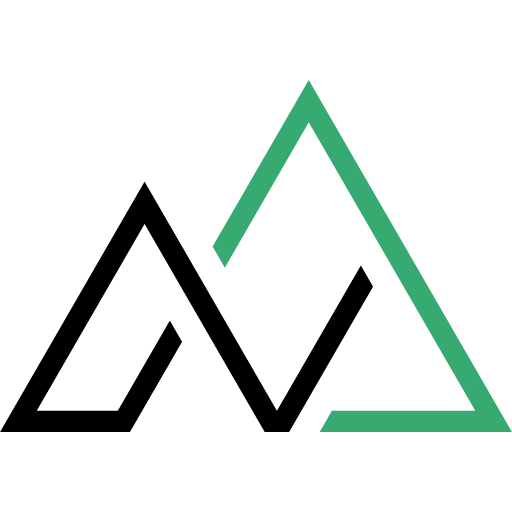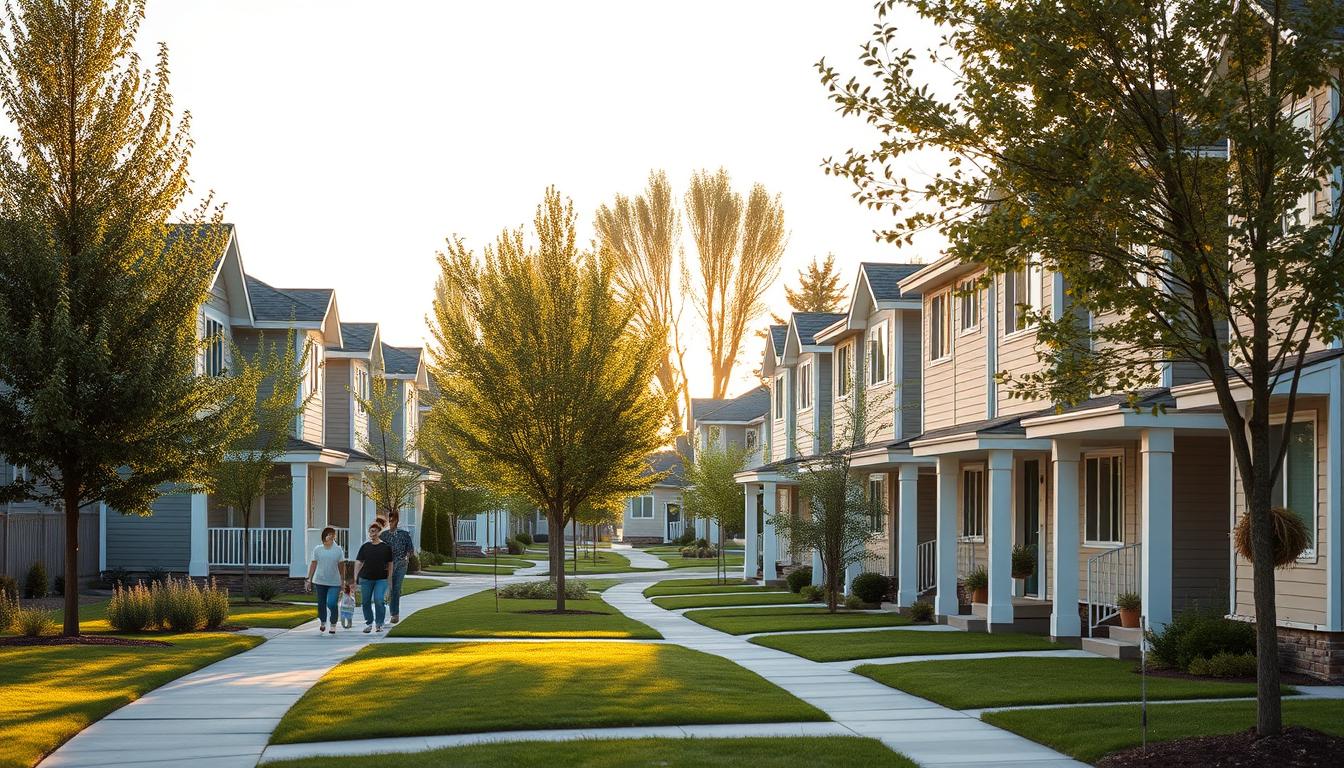Alberta’s real estate market continues to attract attention with its competitive pricing and steady growth. Whether you’re a first-time buyer or an experienced investor, understanding the current trends is essential. With an average home price of $493,828, the market offers opportunities for those looking to make a smart investment.
New Homes Alberta is here to guide you through every step of the process. With expert insights and detailed market analysis, they help you navigate the complexities of the real estate market. From emerging urban developments to stable pricing trends, their team ensures you make informed decisions.
For personalized advice, reach out to New Homes Alberta at (403) 305-9167. Their commitment to providing reliable guidance makes them a trusted partner in your home-buying journey. This article will explore key market trends, pricing, and regional focuses like Calgary and Edmonton, offering a comprehensive review of Alberta’s housing landscape.
Key Takeaways
- Alberta’s real estate market remains stable with an average home price of $493,828.
- New Homes Alberta offers expert guidance and detailed market analysis.
- Emerging urban developments are shaping the housing landscape.
- First-time buyers and investors can benefit from personalized advice.
- This article provides a data-backed review of Alberta’s housing market.
Overview of the Alberta Housing Market in 2025
Economic growth and population trends are reshaping the housing landscape in Alberta. The province’s real estate market remains a dynamic environment, offering opportunities for both buyers and investors. With an average home price of $493,828, the market has shown resilience despite short-term fluctuations.
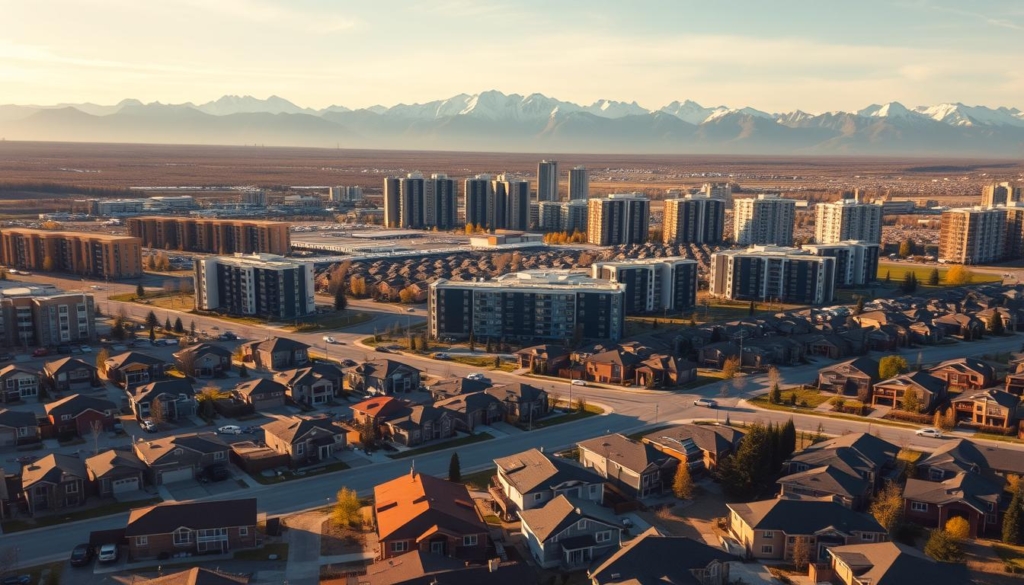
Key economic indicators are driving activity in the housing sector. Alberta’s population has grown by 19.8% from 2014 to 2024, fueling demand for homes. Interprovincial migration has also played a significant role, with many newcomers seeking affordable living options.
Key Economic Growth and Population Trends
Alberta’s economy continues to expand, supported by industries like energy, technology, and agriculture. This growth has created jobs, attracting more people to the province. The population surge has led to increased demand for housing, particularly in urban centers like Calgary and Edmonton.
Year-over-year home prices have risen by 7.7%, reflecting the market’s strength. Despite monthly dips, the overall trend remains positive. Tracking these changes helps buyers and investors understand the market’s direction.
Market Stability and Price Fluctuations
The Alberta housing market is known for its stability, even with short-term price changes. The benchmark home price reached $505,200 in December 2024, up 5.2% from the previous year. This metric is crucial for assessing affordability and market health.
- Average home price: $493,828 (down 1.3% monthly, up 7.7% annually).
- Population growth: 19.8% increase from 2014 to 2024.
- Benchmark home price: $505,200 (up 5.2% year-over-year).
Fluctuations in home prices are natural, but the Alberta housing market remains a reliable choice for those looking to invest or settle down. Understanding these trends is essential for making informed decisions.
The Rise of New Developments and Urban Infrastructure in Alberta
Alberta is witnessing a surge in innovative urban projects reshaping its housing landscape. With a 32% increase in housing starts, the province is addressing the growing demand for homes. These projects focus on sustainability and smart planning, ensuring long-term benefits for residents and investors alike.

Smart Urban Planning and Green Building Initiatives
Modern urban planning in Alberta emphasizes sustainability. Green building materials and energy-efficient systems are becoming standard in new constructions. For example, projects like Nostalgia Calgary and Logan Landing incorporate eco-friendly designs, reducing environmental impact.
These initiatives not only support the environment but also attract investors. Green investments are gaining traction, with many seeing the long-term value in sustainable developments. This trend is reshaping the housing market, offering modern and efficient living spaces.
Impact on Housing Inventory and New Listings
The rise in new developments is boosting housing inventory. In 2024, over 46,632 homes were under construction, a significant increase from previous years. This growth is particularly evident in urban centers like Calgary and Edmonton.
New listings are also influenced by these trends. Sustainable building practices and smart technology adoption are making homes more attractive to buyers. As a result, the market is seeing a steady increase in both supply and demand.
- Over 46,632 new homes are under construction, addressing housing shortages.
- Green building materials and energy-saving systems are becoming standard.
- Smart urban planning is enhancing the quality of life in urban areas.
- Investors are increasingly drawn to sustainable and innovative projects.
- New listings are rising, driven by modern and eco-friendly designs.
These trends highlight the importance of forward-thinking strategies in Alberta’s housing market. By focusing on sustainability and innovation, the province is setting a benchmark for urban development.
Understanding Market Trends and Residential Sales Dynamics
Understanding the dynamics of residential sales is key to navigating Alberta’s real estate market. Year-over-year trends reveal a 7.7% increase in home prices, despite monthly declines of 1.3%. These fluctuations highlight the importance of analyzing both short-term and long-term patterns.
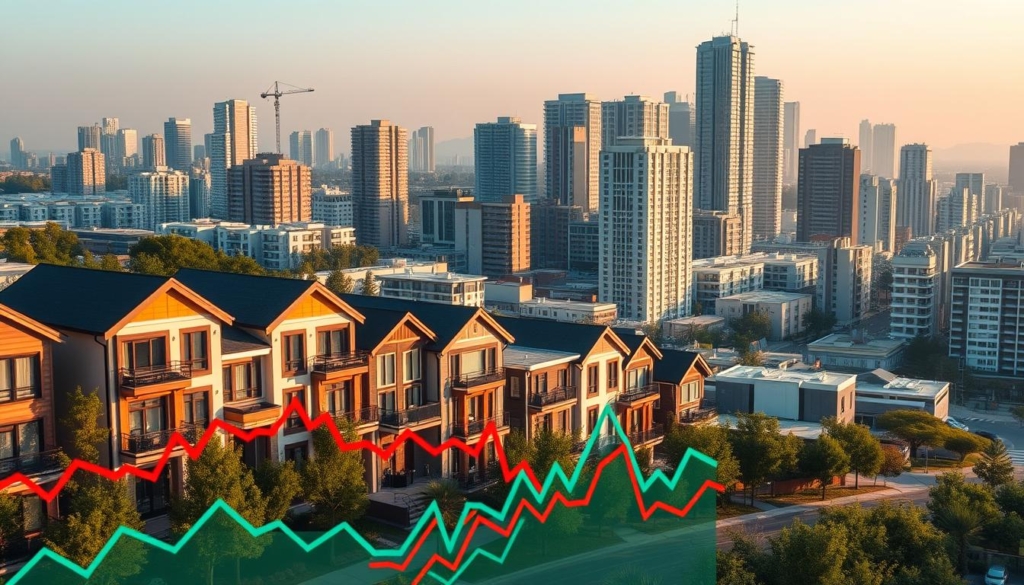
Year-over-Year Price Changes and Sales Activity
In December 2024, the benchmark home price reached $505,200, marking a 5.2% rise from the previous year. This steady growth reflects the market’s resilience, even with periodic dips. Sales activity has also surged, with a 105% sales-to-new listings ratio indicating strong demand.
Factors like interest rates and economic growth play a significant role in driving price increases. For instance, Alberta’s job growth in sectors like technology and renewable energy has boosted buyer confidence. As a result, the market remains attractive for both buyers and investors.
Sales-to-New Listings Ratio Insights
The sales-to-new listings ratio is a critical indicator of market health. A ratio above 100%, like the 105% recorded in December 2024, signals high demand relative to supply. This trend is particularly evident in urban centers like Calgary and Edmonton, where population growth fuels housing needs.
“The sales-to-new listings ratio provides a clear snapshot of supply and demand dynamics, helping buyers and professionals make informed decisions.”
Different property segments are affected uniquely by these trends. For example, detached homes in Calgary saw a 7.3% price increase, while condos appreciated by 6.2%. Understanding these variations is essential for tailoring strategies to specific market segments.
- Year-over-year price growth: 7.7%.
- Sales-to-new listings ratio: 105%.
- Key factors: Interest rates, economic growth, and job creation.
- Urban centers like Calgary and Edmonton drive demand.
These insights underscore the importance of staying informed about market trends. Whether you’re a buyer or a real estate professional, understanding these dynamics can help you navigate the market effectively.
Affordable Houses for Sale Alberta 2025
The concept of affordability in Alberta’s housing market is shaped by various economic and social factors. For many buyers, affordable housing means finding a home that fits their budget while meeting their needs. In Alberta, this often translates to properties priced below the provincial average of $493,828. Understanding what defines affordability and the factors influencing home prices is crucial for making informed decisions.
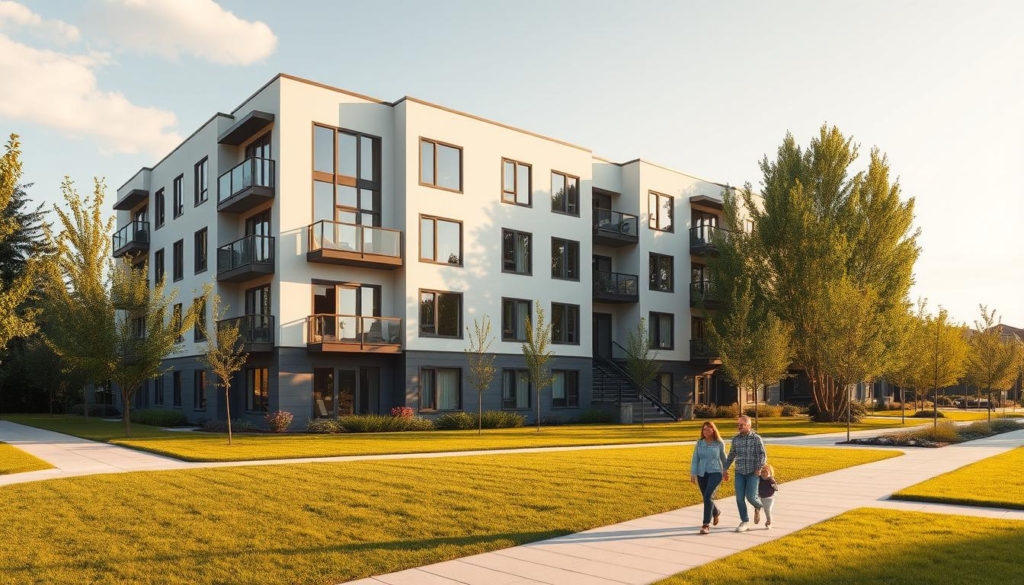
What Defines Affordable Housing in Alberta?
Affordable housing in Alberta is typically characterized by properties that are accessible to low- and middle-income buyers. These homes often fall within a specific price range, such as those in Fort McMurray, where prices range from CAD 164,900 to CAD 359,900. Key features include smaller sizes (around 112 m² to 158 m²) and practical layouts, often with 3 bedrooms and 2 bathrooms.
Government policies also play a significant role in defining affordability. Programs like down payment assistance and tax incentives help make homeownership more attainable. For example, the median price of affordable homes in some areas is CAD 249,900, making them accessible to a broader range of buyers.
Key Factors Influencing Home Prices
Several factors impact home prices in Alberta, making affordability a dynamic concept. Local market conditions, such as supply and demand, are primary drivers. In urban centers like Calgary and Edmonton, high demand often leads to higher prices. However, areas like Camrose and Grande Cache offer more affordable options, with average prices of $258,000 and $246,000, respectively.
Financing options and government incentives also shape affordability. Programs that reduce upfront costs or offer lower interest rates can make homes more accessible. Additionally, benchmarks like the price alberta metric help buyers gauge market trends and make informed decisions.
For real estate investors, affordable housing represents a strong opportunity. Properties in growing towns like Nanton and Pincher Creek, with populations under 4,000, offer potential for long-term growth. These areas are seeing increased interest due to their proximity to larger cities and lower entry costs.
| Location | Average Home Price | Population |
|---|---|---|
| Camrose | $258,000 | 20,000 |
| Nanton | $473,000 | 2,300 |
| Grande Cache | $246,000 | 3,300 |
| Pincher Creek | $289,000 | 3,600 |
Understanding these factors helps buyers and investors navigate Alberta’s housing market effectively. By focusing on affordability, they can find opportunities that align with their financial goals and long-term plans.
City Focus: Calgary’s Dynamic Real Estate Landscape
Calgary’s real estate market is thriving, driven by a mix of economic growth and urban development. The city’s average home price stands at $605,074, reflecting its vibrant market conditions. With a 42% increase in months of supply, Calgary offers a balanced environment for both buyers and sellers.
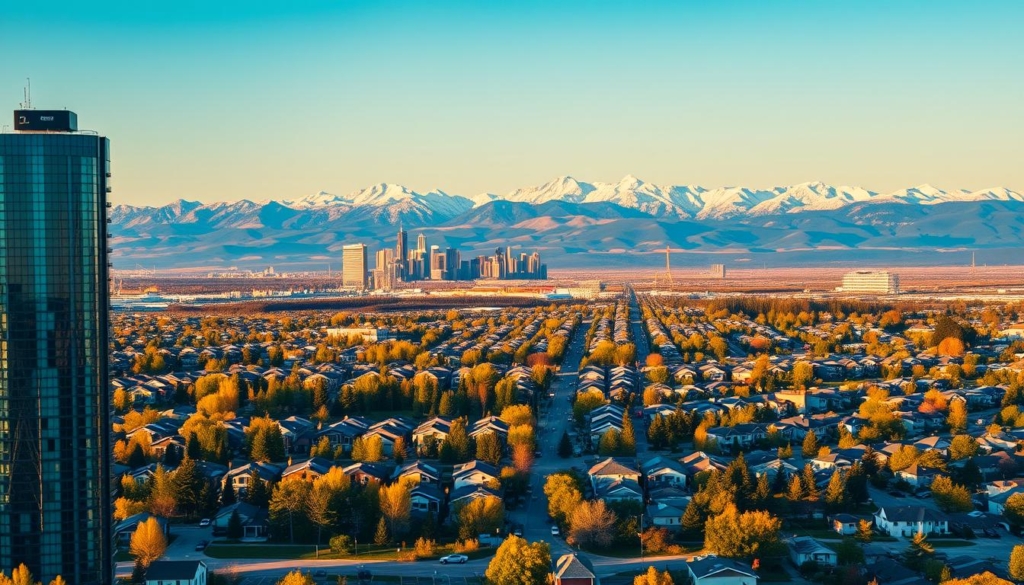
Inventory Trends and Sales Data
Calgary’s inventory trends show a steady rise, with over 3,900 properties listed for sale as of early 2025. This increase in supply has been accompanied by strong sales activity, particularly in the condo segment. Condominium apartment sales in 2024 were 47% higher than historical norms, indicating growing demand.
Benchmark prices for detached homes have surpassed $750,000, while apartments reached $337,800 in November 2024. This upward trend is supported by job growth in sectors like technology and renewable energy, which has boosted buyer confidence.
- Average home price: $605,074.
- Condominium apartment sales: 47% above historical norms.
- Benchmark apartment price: $337,800 (9% year-over-year increase).
Impact of Urban Development on Home Prices
Urban development projects are playing a key role in shaping Calgary’s real estate landscape. Initiatives like the Green Line LRT extension and the Office Conversion Initiative are enhancing connectivity and adding over 1,400 new homes to the market. These projects are driving demand and influencing home prices across the city.
Neighborhoods like Belmont and Seton are seeing rising property values due to their strategic locations and ongoing developments. For example, the median rent in northeast Calgary is $1,800, reflecting the area’s growing appeal. Such trends highlight the importance of urban planning in maintaining market vitality.
“Calgary’s urban development projects are not just transforming the city’s skyline but also its real estate market dynamics.”
As Calgary continues to grow, its real estate market remains a key focus for buyers and investors alike. The city’s blend of economic opportunities and innovative urban planning ensures it stays at the forefront of Alberta’s housing landscape.
City Focus: Edmonton's Emerging Market Potential
Edmonton’s real estate market is gaining momentum, offering unique opportunities for buyers and investors. With a 12% increase in average home prices and a tightening supply, the city is becoming a focal point in Alberta real estate. This growth is driven by strong demand and innovative urban planning, making it a promising destination for those looking to invest or settle down.
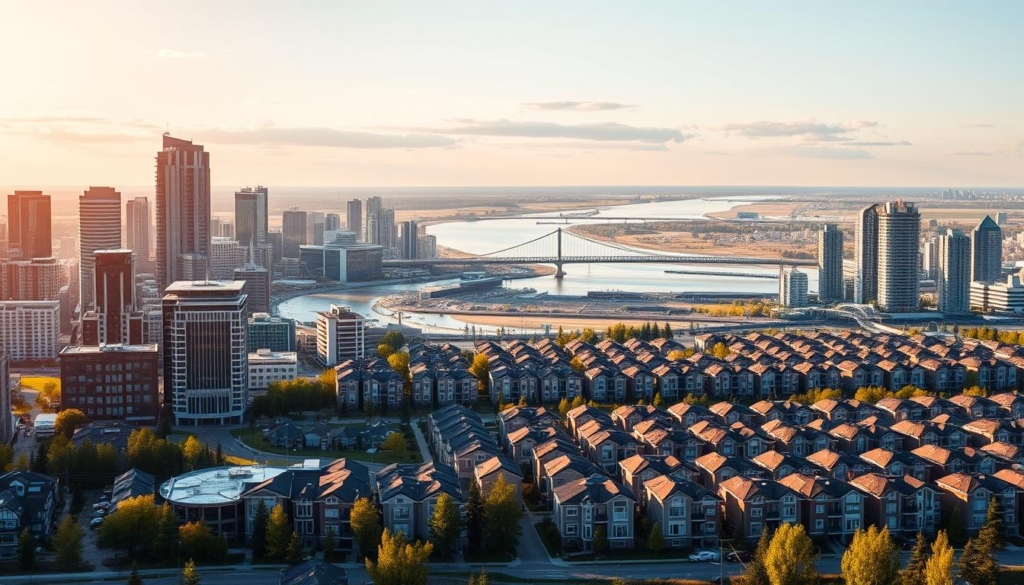
Sales Growth and Residential Demand
Edmonton’s housing market has seen significant sales growth, with a 17.2% increase in December 2024 compared to the previous year. Detached homes led the way with an 18.8% year-over-year rise, while condos and townhouses also showed strong performance. This upward trend reflects the city’s growing appeal as a hub for residential living.
Inventory levels have dropped by 24.6%, creating a competitive environment for buyers. This tightening supply, combined with rising demand, has pushed average home prices to $435,549. For investors, this presents a prime opportunity to capitalize on the city’s expanding market.
- Detached home sales: 18.8% YoY increase.
- Condominium prices: $203,920, up 19.8% YoY.
- Inventory decline: 24.6%, signaling strong demand.
Smart Zoning and Community Developments
Edmonton’s urban planning is shaping its real estate market through smart zoning and community-focused projects. Initiatives like the revitalization of the downtown core and the development of mixed-use spaces are enhancing the city’s livability. These efforts are attracting both residents and businesses, further driving demand for properties.
Neighborhoods like Glenora and Strathcona are seeing increased interest due to their proximity to amenities and transportation hubs. For example, the average rent in these areas has risen to $1,506, reflecting their growing popularity. Such developments highlight Edmonton’s potential as a key player in Alberta real estate.
“Smart zoning practices are transforming Edmonton’s neighborhoods, creating vibrant communities that appeal to a wide range of buyers.”
| Neighborhood | Average Home Price | Key Feature |
|---|---|---|
| Glenora | $550,000 | Proximity to parks and schools |
| Strathcona | $475,000 | Access to public transit |
| Oliver | $400,000 | Downtown location |
As Edmonton continues to evolve, its real estate market offers a blend of stability and growth. Whether you’re a first-time buyer or an experienced investor, the city’s emerging potential makes it a compelling choice in Alberta real estate.
Emerging Trends: Smart Home Technologies and Innovation
Smart home technologies are revolutionizing modern living with advanced digital integration. These innovations are transforming how Canadians interact with their living spaces, offering convenience, efficiency, and enhanced security. From energy monitoring systems to digital security solutions, smart homes are becoming a standard part of modern property developments.

One of the most significant advancements is the integration of energy-efficient systems. Smart thermostats, for example, allow homeowners to monitor and control their energy usage remotely. Programs like the one launched by Ecobee in collaboration with Hydro One offer incentives for adopting these technologies, making them more accessible to the average Canadian household.
Digital security is another area where smart home technologies excel. Systems like smart locks and surveillance cameras provide real-time monitoring and alerts, ensuring homeowners can protect their properties effectively. These innovations not only enhance safety but also contribute to the overall economy by reducing the need for traditional security measures.
“Smart home technologies are not just about convenience; they are reshaping the way we think about resource management and security.”
The impact of these technologies extends beyond individual homes. They are driving activity within the housing sector, encouraging developers to incorporate smart systems into new projects. This trend is particularly evident in Canada, where the demand for energy-efficient and secure homes is growing.
Here’s a breakdown of key smart home technologies and their benefits:
| Technology | Function | Benefit |
|---|---|---|
| Smart Thermostats | Energy Monitoring | Reduces energy costs and improves efficiency |
| Smart Locks | Digital Security | Enhances home safety with remote access |
| Surveillance Cameras | Real-Time Monitoring | Provides peace of mind with instant alerts |
| Smart Lighting | Automated Control | Increases convenience and reduces energy usage |
As these technologies continue to evolve, they are setting new standards for modern living. Whether it’s through energy savings, enhanced security, or improved convenience, smart home innovations are shaping the future of residential design in Canada and beyond.
Strategies for First-Time Homebuyers in Alberta
Navigating the real estate market as a first-time buyer can feel overwhelming, but Alberta offers several programs to simplify the process. Whether you’re looking for government incentives or flexible financing options, there are resources to help you secure your dream property. This section outlines practical strategies to guide you through your home-buying journey.

Government Incentives and Mortgage Assistance
Alberta provides a range of incentives to support first-time buyers. The First-Time Home Buyers’ Tax Credit offers a non-refundable credit of $10,000, resulting in a tax rebate of up to $1,500. Additionally, the Home Buyers’ Plan allows you to withdraw up to $60,000 tax-free from your RRSPs for a down payment.
Mortgage assistance programs are also available to make homeownership more accessible. For example, the First Place Home Ownership Program has income and net worth limits to ensure it benefits those who need it most. These programs can significantly reduce the financial burden of buying your first property.
Financing Options and Down Payment Programs
Financing your first home is easier with Alberta’s down payment programs. The minimum down payment requirement is 5% for properties valued under $500,000. For a home priced at $493,828, this means a down payment of just $24,691.
Programs like Attainable Homes Calgary offer homes below market price, with down payment loans starting at $2,000. These initiatives make it possible for more buyers to enter the market, even with limited savings.
“Government incentives and financing options are game-changers for first-time buyers, making homeownership a realistic goal.”
Here are some key programs to consider:
- First-Time Home Buyer Incentive: Reduces monthly mortgage payments by sharing equity with the government.
- First Home Savings Account (FHSA): Allows annual contributions of up to $8,000, with a total limit of $40,000.
- Down Payment Assistance: Loans and grants to help cover upfront costs.
Strategic planning is essential when buying your first home. Set a realistic budget, explore all available incentives, and work with a trusted real estate professional. These steps will help you navigate the market confidently and secure a property that meets your needs.
Sustainable and Energy-Efficient Housing Solutions
Sustainable housing solutions are reshaping the future of real estate in Alberta, offering both environmental and financial benefits. As the demand for eco-friendly living grows, builders and buyers are increasingly turning to green technologies and energy-efficient designs. These innovations not only reduce environmental impact but also lower long-term operating costs, making them a smart choice for homeowners and investors alike.
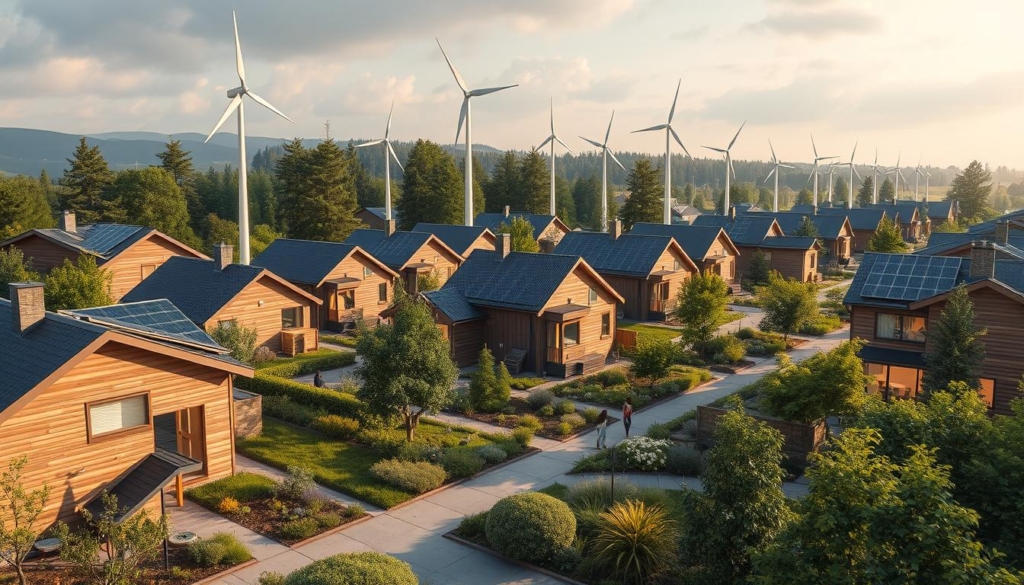
Green Building Materials and Energy Saving Systems
Green building materials are at the heart of sustainable housing. From recycled steel to low-VOC paints, these materials minimize environmental harm while enhancing durability. Energy-saving systems, such as smart thermostats and solar panels, further boost efficiency. For example, Jayman BUILT’s Core Performance homes save homeowners $582 annually while reducing greenhouse gas emissions by 5.09 metric tonnes per year.
Digital energy management systems are also gaining traction. These systems allow homeowners to monitor and optimize their energy usage in real time. Programs like Ecobee’s collaboration with Hydro One provide incentives for adopting such technologies, making them more accessible to the average household.
Long-Term Economic and Environmental Benefits
The economic advantages of sustainable housing are undeniable. Lower utility bills and reduced maintenance costs translate into significant savings over time. For instance, Jayman’s Solar Energized Hybrid Performance homes save $776 annually, offering a quick return on investment.
Environmentally, these solutions contribute to a healthier planet. By reducing energy consumption and greenhouse gas emissions, sustainable housing helps combat climate change. Initiatives like the $300 million SAH program support retrofitting and constructing energy-efficient homes, further driving this positive impact.
“Sustainable housing is not just a trend; it’s a necessity for a greener future and a stronger economy.”
Here’s a breakdown of key benefits:
- Reduced energy costs: Annual savings of up to $1,622 per home.
- Lower greenhouse gas emissions: Up to 10.84 metric tonnes saved annually.
- Increased home value: Energy-efficient homes often command higher market prices.
- Improved supply dynamics: More efficient designs help meet growing housing demands.
By embracing sustainable and energy-efficient solutions, Alberta is setting a benchmark for modern living. These innovations not only benefit homeowners but also contribute to a healthier environment and a stronger economy.
Investment Potential and Market Forecasts for 2025
Alberta’s real estate market in 2025 presents a compelling landscape for investors, driven by robust economic indicators and promising growth opportunities. With an average home price of $506,700, the market remains accessible while offering significant potential for returns. Understanding the factors shaping this real estate market is essential for making informed decisions.

Key Economic Indicators Driving Real Estate Investment
Several economic factors are influencing Alberta’s housing market. The province’s unemployment rate stands at 5.5%, reflecting a stable job market. Weekly earnings have grown by 3.1%, boosting consumer confidence and purchasing power. These indicators create a favorable environment for investment in residential properties.
Population growth is another critical driver. Alberta’s population increased by 19.8% from 2014 to 2024, with a 4.4% rise in Q4 2024 alone. This surge fuels demand for housing, particularly in urban centers like Calgary and Edmonton. For investors, this translates to a steady stream of potential tenants and buyers.
“Population growth and economic stability are key drivers of real estate demand, making Alberta a prime market for long-term investments.”
Here’s a snapshot of key economic indicators:
| Indicator | Value |
|---|---|
| Unemployment Rate | 5.5% |
| Weekly Earnings Growth | 3.1% |
| Population Growth (2014-2024) | 19.8% |
Long-Term Growth and Profit Opportunities
Alberta’s real estate market offers diverse opportunities for growth. The average annual return on investment (ROI) for rental properties in Calgary ranges from 8% to 12%. Real Estate Investment Trusts (REITs) are also gaining traction, with expected returns of 5% to 10%. These options cater to both seasoned investors and newcomers.
Market forecasts predict a 3% to 5% increase in Calgary’s average home price in 2025. Edmonton is expected to see a 2% to 4% rise, driven by affordability and emerging industries like healthcare. These projections highlight the potential for capital appreciation and rental income.
- Calgary’s suburban areas are anticipated to see high demand, offering growth opportunities.
- Edmonton’s affordability makes it attractive for first-time buyers, ensuring steady market activity.
- Diversified portfolios in both cities can maximize returns while mitigating risks.
Strategic investment in Alberta’s real estate market aligns with broader economic stability. By focusing on key indicators and long-term trends, investors can capitalize on the province’s dynamic housing landscape.
"Closing Thoughts on New Homes in Alberta"
The Alberta housing market offers a mix of stability and opportunity for both buyers and investors. With an average home price of $506,700, the market remains accessible while showing steady growth. Urban centers like Calgary and Edmonton are leading the way, driven by population increases and innovative development projects.
Key trends include a 7.7% year-over-year price increase and a 105% sales-to-new listings ratio, indicating strong demand. For investors, the market presents diverse opportunities, from rental properties to sustainable developments. First-time buyers can benefit from government incentives and flexible financing options.
As the market evolves, staying informed is crucial. Relying on expert, data-driven advice from New Homes Alberta ensures you make confident decisions. Whether you’re buying your first home or expanding your portfolio, Alberta’s real estate landscape offers long-term potential.
For personalized guidance, contact New Homes Alberta at (403) 305-9167. Their team is ready to help you navigate the market and achieve your goals.
